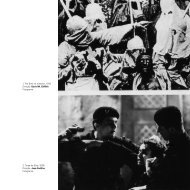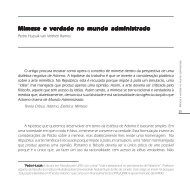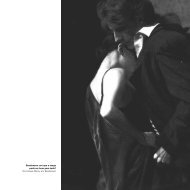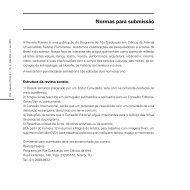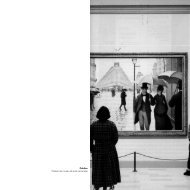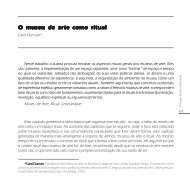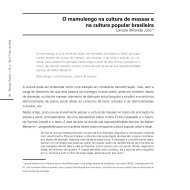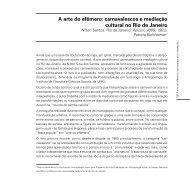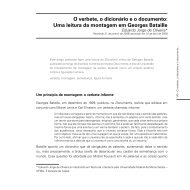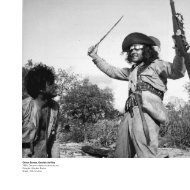Untitled
Untitled
Untitled
You also want an ePaper? Increase the reach of your titles
YUMPU automatically turns print PDFs into web optimized ePapers that Google loves.
Abstracts<br />
Critical Narrative: Art and Memory<br />
Mauricius Martins Farina<br />
The Guest Editor has prepared a dossier bringing together two researchers, Etienne Samin<br />
and Maria de Fatima Morethy Couto. In their texts, they discuss theories of two important<br />
authors, Aby Walburg and Hal Foster, who, though separated in time and epistemological<br />
orientation, are connected by their interest in the complexity of symbolic images<br />
Aby Walburg, Hal Foster, theory of the image<br />
Painting in Question: Art and Criticism in The 1980s<br />
Maria de Fátima Morethy Couto<br />
This paper aims to analyze the 1980s and 1990s’ debate about the return to painting, both in<br />
the Brazilian art scene as well as abroad. It presents different aspects of the polemic debate<br />
between the proponents of a political art and those who celebrated the return to a subjective<br />
art and to conventional modes of representation.<br />
neoexpressionism, art and politics, art criticism<br />
193 - Abstracts<br />
The Mnemosyne(S) of Aby Warburg. Between Anthropology, Images, and Art The<br />
Mnemosyne(S) of Aby Warburg. Between Anthropology, Images, and Art<br />
Etienne Samain<br />
It has become urgent to rethink the role of images and of art into a necessary reformulation<br />
of anthropologists’ work. This essay presents Aby Warburg – who is both an art historian and<br />
an anthropologist - and the double dimension of his work Mnemosyne, including the elliptical<br />
Library of Hamburg and the Atlas of Images. By submerging itself in the images of the last<br />
plank of the Atlas, the paper seeks to outline certain methodological and heuristic paths in an<br />
attempt to reveal how images think and produce knowledge.<br />
mnemosyne, Aby Warburg, anthropology, images, art
Helio Oiticica’s Excrita<br />
Tania Rivera<br />
194 - Revista Poiésis, n 17, p.193-196, Jul. de 2011<br />
Reflecting on Hélio Oiticica’s texts, this essay proposes reading them as a theoretical/poetic<br />
field on which the artist elaborates his “propositions.” At the same time, Oiticica deals with<br />
the transformation of language in objects, in a similar way as he does in his visual works. In<br />
this paper, we explore the idea of a dispersive and topological metaphor, a language operation<br />
in which there is no substitution, but in which one thing is always related to others in a<br />
disruptive way.<br />
Hélio Oiticica, writings, language, object, metaphor<br />
Sherrie Levine: Allegory as Tautology (and Vice Versa)<br />
Cezar Bartholomeu<br />
Sherrie Levine’s work presents new problems in art history as well as in the history of photography,<br />
especially in questioning authorship. This article critiques her work as a conceptually<br />
conceived event, something that emphasizes other types of strategies in her work and reveals<br />
a different approach towards art history and the concept of photography itself.<br />
photography, art, allegory<br />
Painting is a Trace of Our Historical Relationship with the World<br />
Arley Andriolo<br />
This article aims to discuss the relevance of paintings as an expression of the historical dimension<br />
of perception in Merleau-Ponty’s writings, considering the aesthetic experience to<br />
be based on works of art. Each artist develops the historical categories oriented towards his<br />
or her perspective, adding and changing themes and points of view, but always working within<br />
a social and psychological structure of the perception process.<br />
phenomenology, aesthetics, perception
The Institutional Theory and the Definition of Art<br />
Noéli Ramme<br />
“The Artworld,” the first article on art written by Arthur Danto in 1964, inspired the philosophers<br />
Richard George Dickie and Sclafani to build what became known as the Institutional<br />
Theory of Art. According to this theory, a work of art is “a device to which one or more persons<br />
acting on behalf of a certain social institution (the art world) give the status of candidate for<br />
appreciation.” Despite the apparent circularity of this argument, which seems to say only that<br />
what we call art is art, it has become quite widespread and widely accepted, mainly because<br />
it seems especially appropriate to address certain specific issues raised by contemporary art.<br />
I will discuss the possible advantages and disadvantages in contrast to the opposite theory:<br />
that an object can only be considered a work of art if it produces a unique kind of experience,<br />
called an aesthetic experience, in its viewer.<br />
definition of art, art world, aesthetic experience<br />
195 - Abstracts<br />
Between the Aesthetic and the Political: O Sensus Comunnis<br />
Jean-Philippe Uzel<br />
The author, questioning the political scope of certain artistic practices today, looks back to the<br />
origin of the Fine Arts system in the public space of the salons in the 18th Century to understand<br />
how the political form of community aesthetics was configured for the first time.<br />
art salons, judgment of taste, aesthetic community<br />
Experience as Power for Social Transformation<br />
Luciano Vinhosa<br />
In this article, I investigate the potential for social transformation in the aesthetic experience,<br />
attempting to understand its political dimension and how certain artistic practices are ongoing<br />
in specific contexts.<br />
current artistic practices, aesthetic experience, politics
The Aesthetic Community<br />
Jacques Rancière<br />
196 - Revista Poiésis, n 17, p.193-196, Jul. de 2011<br />
Starting from the fifteenth letter of Schiller’s work Letters on the Aesthetic Education of Man,<br />
Rancière examines the paradoxical relation between aesthetic subjectivity and the community<br />
that it forms. The political implications of this relationship and its metamorphoses are designed<br />
in three major scenarios, which culminate in the construction of what the author calls<br />
anti-aesthetic contemporary resentment.<br />
Schiller, aesthetic community, politics



